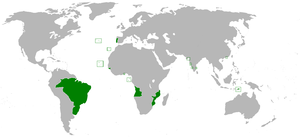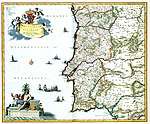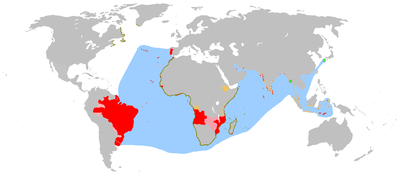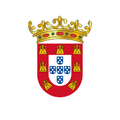Kingdom of Portugal
The Kingdom of Portugal (Latin: Regnum Portugalliae, Portuguese: Reino de Portugal) was a monarchy on the Iberian Peninsula and the predecessor of the modern Portuguese Republic. It was in existence from 1139 until 1910. After 1415, it was also known as the Kingdom of Portugal and the Algarves, and between 1815 and 1822, it was known as the United Kingdom of Portugal, Brazil and the Algarves. The name is also often applied to the Portuguese Empire, the realm's extensive overseas colonies.
Kingdom of Portugal[lower-alpha 1] Regnum Portugalliae (Latin) Reino de Portugal (Portuguese) | |||||||||||||
|---|---|---|---|---|---|---|---|---|---|---|---|---|---|
| 1139–1910 | |||||||||||||
.svg.png) Coat of arms (1640–1910)
| |||||||||||||
Anthem: "Hymno Patriótico" (1809–1834) "Patriotic Anthem" Hino da Carta (1834–1910) "Anthem of the Charter" | |||||||||||||
 The Kingdom of Portugal in 1800 | |||||||||||||
| Capital | Coimbra (1139–1255) Lisbon[a] (1255–1808) Angra do Heroísmo[b] (1580–1582) Rio de Janeiro (1808–1821) Lisbon (1821–1910) Angra do Heroísmo[c] (1830–1834) | ||||||||||||
| Common languages | Official languages: Unofficial languages: | ||||||||||||
| Religion | Majority: Roman Catholicism (official) Minority: Sephardic Judaism[lower-alpha 7] Islam[lower-alpha 8] | ||||||||||||
| Government | Absolute monarchy (1139–1822; 1823–1826; 1828–1834) Constitutional monarchy (1822–1823; 1826–1828; 1834–1910) | ||||||||||||
| Monarch | |||||||||||||
• 1139–1185 (first) | Afonso I | ||||||||||||
• 1908–1910 (last) | Manuel II | ||||||||||||
| Prime Minister | |||||||||||||
• 1834–1835 (first) | Marquis of Palmela | ||||||||||||
• 1910 (last) | Teixeira de Sousa | ||||||||||||
| Legislature | Cortes Gerais | ||||||||||||
• Upper house | Chamber of Peers | ||||||||||||
• Lower house | Chamber of Deputies | ||||||||||||
| History | |||||||||||||
| 25 July 1139 | |||||||||||||
| 1 December 1640 | |||||||||||||
| 1 February 1908 | |||||||||||||
| 5 October 1910 | |||||||||||||
| Area | |||||||||||||
| 1300[1] | 90,000 km2 (35,000 sq mi) | ||||||||||||
| 1910 (metro) | 92,391 km2 (35,672 sq mi) | ||||||||||||
| Population | |||||||||||||
• 1300[1] | 800,000 | ||||||||||||
• 1910 (metro) | 5,969,056 | ||||||||||||
| Currency | Portuguese dinheiro, (1139–1433) Portuguese real (1433–1910) | ||||||||||||
| ISO 3166 code | PT | ||||||||||||
| |||||||||||||
a. ^ The capital was de facto located at Rio de Janeiro from 1808 to 1821.
b. ^ The seat of government of the Portuguese pretender António was de facto located at Angra do Heroísmo from 1580 to 1582. c. ^ The capital of the constitutional government in exile was de jure located at Angra do Heroísmo during the Portuguese Civil War, from 1830 to 1834. | |||||||||||||
Part of a series on the |
|---|
| History of Portugal |
 |
|
|
| Timeline |
|
|
The nucleus of the Portuguese state was the County of Portugal, established in the 9th century as part of the Reconquista, by Vímara Peres, a vassal of the King of Asturias. The county became part of the Kingdom of León in 1097, and the Counts of Portugal established themselves as rulers of an independent kingdom in the 12th century, following the battle of São Mamede. The kingdom was ruled by the Alfonsine Dynasty until the 1383–85 Crisis, after which the monarchy passed to the House of Aviz.
During the 15th and 16th century, Portuguese exploration established a vast colonial empire. From 1580 to 1640, the Kingdom of Portugal was in personal union with Habsburg Spain.
After the Portuguese Restoration War of 1640–1668, the kingdom passed to the House of Braganza and thereafter to the House of Braganza-Saxe-Coburg and Gotha. From this time, the influence of Portugal declined, but it remained a major power due to its most valuable colony, Brazil. After the independence of Brazil, Portugal sought to establish itself in Africa, but was ultimately forced to yield to the British interests, leading to the collapse of the monarchy in the 5 October 1910 revolution and the establishment of the First Portuguese Republic.
Portugal was an absolute monarchy before 1822. It rotated between absolute and constitutional monarchy from 1822 until 1834, and was a constitutional monarchy after 1834.
History
Origins
The Kingdom of Portugal finds its origins in the County of Portugal (1096–1139). The Portuguese County was a semi-autonomous county of the Kingdom of León. Independence from León took place in three stages:
- The first on 26 July 1139 when Afonso Henriques was acclaimed King of the Portuguese[2] internally.
- The second was on 5 October 1143, when Alfonso VII of León and Castile recognized Afonso Henriques as king through the Treaty of Zamora.
- The third, in 1179, was the Papal Bull Manifestis Probatum, in which Portugal's independence was recognized by Pope Alexander III.
Once Portugal was independent, D. Afonso I's descendants, members of the Portuguese House of Burgundy, would rule Portugal until 1383. Even after the change in royal houses, all the monarchs of Portugal were descended from Afonso I, one way or another, through both legitimate and illegitimate links.
 An anachronous map of the Portuguese Empire
An anachronous map of the Portuguese Empire
Medieval history (1139–1415)
Renaissance and early modern history (1415–1777)
Modern history (1777–1910)
Fall of the Monarchy
With the start of the 20th century, Republicanism grew in numbers and support in Lisbon among progressive politicians and the influential press. However a minority with regard to the rest of the country, this height of republicanism would benefit politically from the Lisbon Regicide on 1 February 1908. While returning from the Ducal Palace at Vila Viçosa, King Carlos I and the Prince Royal Luís Filipe were assassinated in the Terreiro do Paço, in Lisbon. With the death of the King and his heir, Carlos I's second son would become monarch as King Manuel II. Manuel's reign, however, would be short-lived, ending by force with the 5 October 1910 revolution, sending Manuel into exile in Great Britain and giving way to the Portuguese First Republic.
On 19 January 1919, the Monarchy of the North was proclaimed in Porto. The monarchy would be deposed a month later and no other monarchist counterrevolution in Portugal has happened since.
After the republican revolution in October 1910, the remaining colonies of the empire became overseas provinces of the Portuguese Republic until the late 20th century, when the last overseas territories of Portugal were handed over (most notably Portuguese Africa which included the overseas provinces of Angola and Mozambique in 1975, and finally Macau in 1999).
Rulers
Gallery
.png) Flag of the Kingdom of Portugal (1185–1248)
Flag of the Kingdom of Portugal (1185–1248).png) Flag of the Kingdom of Portugal (1248–1385)
Flag of the Kingdom of Portugal (1248–1385).png) Flag of the Kingdom of Portugal (1385–1481)
Flag of the Kingdom of Portugal (1385–1481).png) Flag of the Kingdom of Portugal (1481–1495)
Flag of the Kingdom of Portugal (1481–1495) Flag of the Kingdom of Portugal (1495–1521)
Flag of the Kingdom of Portugal (1495–1521) Flag of the Kingdom of Portugal (1521–1578)
Flag of the Kingdom of Portugal (1521–1578) Flag of the Kingdom of Portugal (1580–1610)
Flag of the Kingdom of Portugal (1580–1610).png) Coat of arms of the Kingdom of Portugal (1610–1815)
Coat of arms of the Kingdom of Portugal (1610–1815)_Rei_de_Portugal.jpg) Arms of the King of Portugal depicted in the Livro do Armeiro-Mor (c. 1509)
Arms of the King of Portugal depicted in the Livro do Armeiro-Mor (c. 1509)
See also
Footnotes
- After 1415, it was also known as the Kingdom of Portugal and the Algarves (Latin: Regnum Portugalliae et Algarbiae, Portuguese: Reino de Portugal e dos Algarves), and between 1815 and 1822, it was known as the United Kingdom of Portugal, Brazil and the Algarves (Portuguese: Reino Unido de Portugal, Brasil e Algarves).
- Galician-Portuguese (until 16th century)
Modern Portuguese (16th century onward) - Widely used for administrative and liturgical purposes. Medieval Latin replaced by Renaissance Latin by the 15th century.
- Until 13th century.
- Until 1497, mainly in the Algarve.
- Until 1497.
- Until 1497.
- Until 1497.
Citations
- Reilly, Bernard F. (1993). The Medieval Spains. Cambridge University Press. p. 139. ISBN 9780521397414. Retrieved 11 October 2019.
The new kingdom of Castile had roughly tripled in size to some 335,000 square kilometers by 1300 [...] Portugal swollen to 90,000 square kilometers and perhaps 800,000 inhabitants [...]
- Wilner, Hero, Weiner, p. 190
References
- Joaquim Veríssimo Serrão, História de Portugal: Do mindelo á regeneração (1832–1851)
- José Mattoso, António Manuel Hespanha, História de Portugal 4: O Antigo Regime (1620–1807), (1998) ISBN 972-33-1311-1
- Simão José da Luz Soriano, Historia da Guerra Civil e do estabelecimento do governo parlamentar em Portugal: comprehedendo a historia diplomatica, militar e politica d'este reino desde 1777 até 1834 Volume 9 (1893)
- Jacinto de São Miguel (Frei), Martinho Augusto Ferreira da Fonseca, Mosteiro de Belém: Relação da insigne e real casa de Santa Maria de Belém (1901)
- Mark Willner, George Hero, Jerry Weiner, Global History Volume I: The Ancient World to the Age of Revolution (2006) ISBN 978-0-7641-5811-7
- Douglas L. Wheeler, Republican Portugal: A Political History, 1910–1926 (1998) ISBN 978-0-299-07454-8
.svg.png)